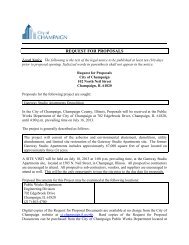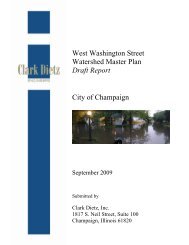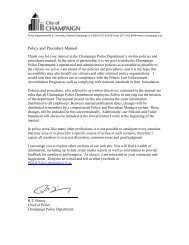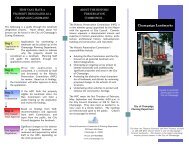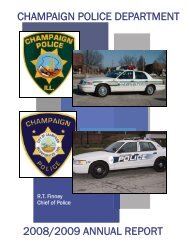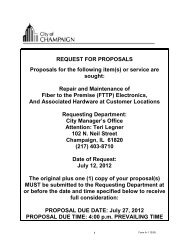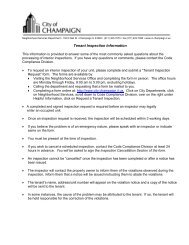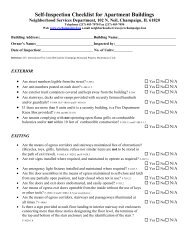2010-2014 Consolidated Plan - City of Champaign
2010-2014 Consolidated Plan - City of Champaign
2010-2014 Consolidated Plan - City of Champaign
Create successful ePaper yourself
Turn your PDF publications into a flip-book with our unique Google optimized e-Paper software.
Discharge Coordination PolicyContinuum agencies have been working individually with the Illinois Department <strong>of</strong> Corrections to build anetwork <strong>of</strong> support for inmates/parolees being released to the area who are HIV positive. When a personwho has been incarcerated is released or paroled, they leave the correctional institution with only oneweek’s supply <strong>of</strong> HIV medications, but the process <strong>of</strong> enrolling a consumer on ADAP takes four weeksafter they enter the community. Persons with mental health issues are released without adequatesupplies <strong>of</strong> medications. The need to build communication lines with DOC is critical to establishing thelink between released prisoners and services across the entire continuum <strong>of</strong> providers. As one <strong>of</strong> thegoals <strong>of</strong> the Continuum is to establish a discharge policy, it is important that continuum members work tobuild a positive relationship with DOC staff. The TIMES Center Advisory Group, which oversees the policyand procedures <strong>of</strong> the area’s largest service provider to homeless men, will work with staff from the <strong>City</strong><strong>of</strong> Urbana to set up meetings and try to establish dialogue with the IL Department <strong>of</strong> Corrections.Additionally, Mental Health Center <strong>of</strong> <strong>Champaign</strong> County has been mandated to provide casemanagement, referrals and linkage <strong>of</strong> services to state operated facilities and hospitals dischargingpersons with serious mental illnesses. Provena also employs a forensic case manager to assure servicesare secured once mentally ill inmates are released. The Continuum will call on this agency’s expertisewhen negotiating with the IL Department <strong>of</strong> Corrections.SERVICES FOR THE NEAR-HOMELESSThe rising number <strong>of</strong> near-homeless persons is evident in this area. In the Community NeedsAssessment study, about one in eight (17%) participants said that at some point they had given uppaying for food, utilities or healthcare to make the rent or mortgage payment. Excessive rent burden isthe most prevalent problem for low-income renters. The August 2009 homeless survey revealed that 62persons were homeless due to the inability to pay their rent or mortgage.The primary means for preventing homelessness is emergency rent assistance. <strong>Champaign</strong> CountyRegional <strong>Plan</strong>ning Commission (CCRPC) provides rent assistance to persons facing eviction. The CCRPCalso provides first-month’s rent for homeless persons and past-due rent for near-homeless persons.Recent federal stimulus funding provided four local agencies with additional homeless prevention andrapid re-housing funds: A Woman’s Fund, Mental Health Center <strong>of</strong> <strong>Champaign</strong> County, Center forWomen in Transition, and additional funding for CCRPC. The <strong>City</strong> <strong>of</strong> <strong>Champaign</strong> and the Urbana HOMEConsortium also provide tenant based rent assistance in order to help households access affordable rentalunits while working towards self-sufficiency.SECTION 3E: HOUSING NEEDS OF SPECIAL POPULATIONS 91.205(d) and 91.210(d)INTRODUCTIONThis section will discuss the housing needs <strong>of</strong> persons with special needs who are not homeless but are inneed <strong>of</strong> supportive services. Persons with special needs include: the frail and non-frail elderly, personswith mental, physical, and/or developmental disabilities, persons with alcohol or drug addictions andpersons diagnosed with AIDS/HIV. The assistance to persons with special needs is mainly provided bylocal non-pr<strong>of</strong>it agencies and organizations, which receive local and state funding, private foundationgrants, private donations and federal grants.40 Needs Assessment: Housing and Homelessness



